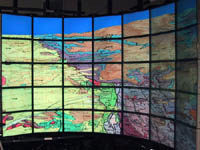Optical Race and TRECC HPCwire Press Release
January 27th, 2006
Categories: Applications, Devices, Networking, Visualization

About
Optical Race
by Kathleen Ricker
Research editor, NCSA
It’s an accepted fact that, no matter how rapid the pace of technology development, the needs of industry and research and development will always be greater. Computational infrastructure such as the TeraGrid, in which middleware on large, fast machines based at supercomputing centers and universities across the nation is networked via fast Ethernet connections, already handles 40 gigabits of data per second.
But as Grid infrastructure grows, so do data needs - which are now in the range of terabytes. And researchers collaborating over large distances are more interested than ever in the possibility of real-time decision making, which would allow geographically remote groups to view and work simultaneously with the same large datasets or large-scale, high-resolution visualizations. Research communities such as environmental engineers and oceanographers - the latter heavily involved in Navy-supported research - have specific needs for technology that will make responding to environmental hazards and monitoring water supplies and other natural resources more efficient.
The OptIPuter is a computing paradigm in which dynamically controllable optical networks become the system bus that connects cluster computers as if they were giant peripherals in a planetary-scale computer. (The IP in OptIPuter refers to the fact that it uses Internet Protocol as the standard for data transmission.) Supported by National Science Foundation’s Information Technology Research (ITR) program, the OptIPuter aims to deliver the middleware and end-user software that will allow geoscientists and bioscientists to work with enormous data-sets in real-time over thousands of miles of fiber-optic cable that are part of an emerging Lambda Grid that connects sites like TRECC, NCSA, UCSD, and EVL at UIC.
EVL is now partnering with TRECC to deploy new visualization and other user interface technologies at the TRECC facility in West Chicago. It’s a collaboration that’s been going on for three years now and that began with the installation of the Continuum at TRECC in 2001. “The Continuum is really the prototype for OptIPuter collaboration environments,” says Jason Leigh of EVL, who currently leads the project to make TRECC an OptIPuter node. “In other words, they should be extremely display-rich environments, with the ability to wallpaper a high-definition video stream and high-resolution visualization content, and to be able to work collaboratively with this data over distance.”